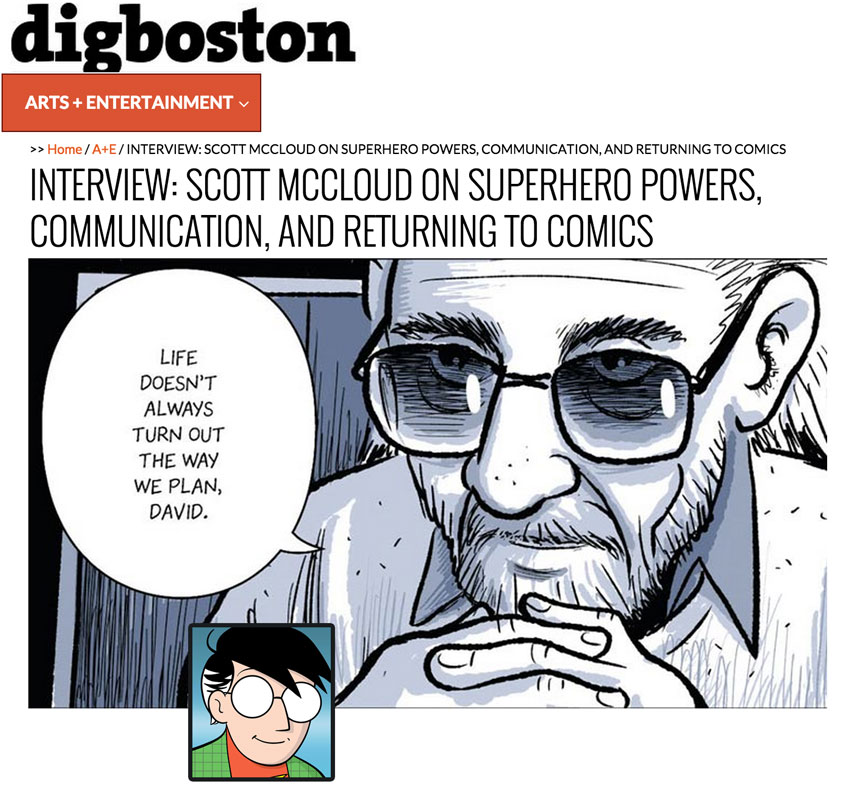INTERVIEW: SCOTT MCCLOUD ON SUPERHERO POWERS, COMMUNICATION, AND RETURNING TO COMICS - EARTH PRIME TIME AT DIGBOSTON
INTERVIEW: SCOTT MCCLOUD ON SUPERHERO POWERS, COMMUNICATION, AND RETURNING TO COMICS

Scott McCloud defined the language of comic book creation and critical thought with his lauded 1993 tome Understanding Comics: The Invisible Art. In advance of his appearance at Brattle Theatre in Harvard Square on Thursday, February 5, I got a chance to talk with him about his latest 500 page graphic novel, The Sculptor, and his glorious return to comics.
What can readers expect from The Sculptor?
For starters, it’s big. It’s just under 500 pages long and it is a story about a young sculptor in New York City who had a taste of early success and is now contemplating his life as a loser when he gets an opportunity from a visitor to have everything he needs to succeed — at least physically — but he has only 200 days to live. It’s a traditional Faustian bargain, [but] this time the supernatural visitor is Death, not The Devil. I’m not too keen on devils and Hell, being an atheist.
The real challenge [for the main character] is an internal one because as soon as he has power to mold anything with his bare hands, he runs up against his own artistic limitations and desires, and finds it isn’t so easy. When all the other obstacles drop away, there are still those internal obstacles.
Then he crashes headlong into this romance at the eleventh hour, and the question of how to spend one’s days becomes critical for him.
It is a race against the clock in a way. He has a superpower and it’s about how he deals with having a finite number of days. He can also be penalized if he makes certain decisions, he then has less days. I was seeing these as very much comic book ideas.
Yeah, and this is something I had to come to grips with myself, because I was going around for decades talking about how comics can be more than just superheroes. Then I have an idea that I love but it has that superhero quality to it. This is one of the reasons why when the book starts we see that this wish of his in part grows out of the thing he did as a kid. He made a comic where he had a power sort of like this.
You are working with these huge archetypes. How did you go about laying out this whole story over 500 pages, incorporating superhero ideas? Was that all there at the beginning?
Part of it was, the idea of Death was there. The conceit of what appears to be an angel at the beginning came to me [during] the actual making of it. There were a few decades before I started in earnest working on the project, then there were the five years that took me to make the thing.
Is what prompted so many revisions was wanting to try different things out?
It was more that the story was starting to come to focus in my mind. The first revision was about fixing things. With each revision, it became about excavating what was below the crap. Seeing the shape of the story of what it wanted to be and pull that story out. Occasionally I would have a neat little bit, something that works with comics or was interesting, and then I would realize that while it might be nice—it didn’t really belong. It didn’t really have anything to do with what that story was ultimately about. If you can pull it off, if you can have the parts reflect the whole, that’s hopefully a book that feels like it has a breathing heart, [that] breathes when it is on the shelf at night.
[READ MORE AT DIGBOSTON.COM]



